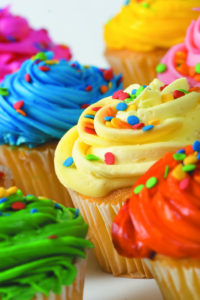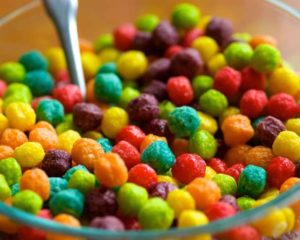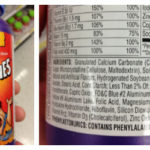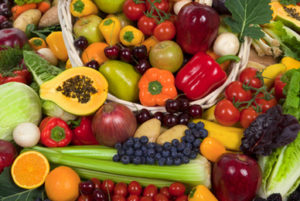Color Struck!
Blog #7 Color Struck!
 We are eating with our eyes! Oh, I like the Red one. No, give me the green one, I’ll have the pink one, and I’ll have the blue one. They are all so beautifully decorated, and the children will love these. Colored candy, cereal, cupcakes, water ice (a Philly thing) lure us in with child-like anticipation of the taste and satisfaction. As humans we are attracted to colors. The more brilliant the colors, the closer we are drawn to them. It’s not an American phenomenon. It is a human phenomenon. According to Instant Knockout.com, “It [color] can affect our mood and motivation, arousal, and productivity. It can make us feel warm or cold, happy or sad. Visual stimuli is important in driving us, and nature teaches us to make a judgment based largely on what stimuli we are presented with”.
We are eating with our eyes! Oh, I like the Red one. No, give me the green one, I’ll have the pink one, and I’ll have the blue one. They are all so beautifully decorated, and the children will love these. Colored candy, cereal, cupcakes, water ice (a Philly thing) lure us in with child-like anticipation of the taste and satisfaction. As humans we are attracted to colors. The more brilliant the colors, the closer we are drawn to them. It’s not an American phenomenon. It is a human phenomenon. According to Instant Knockout.com, “It [color] can affect our mood and motivation, arousal, and productivity. It can make us feel warm or cold, happy or sad. Visual stimuli is important in driving us, and nature teaches us to make a judgment based largely on what stimuli we are presented with”.
These psychological and physical associations with color are often more potent than the colors themselves – blues are calming, reds and oranges are exciting and full of energy. We might associate white with purity and black with a more somber mood. Green, of course, reminds us of nature and health. Reported by an article on the internet. (listed below) My question is, what is the health impact on the human body? How much testing was done to determine these dyes’ constant ingestion long-range effects? Are we poisoning ourselves, and what are the alternatives to chemically-treated dyes?
“Food Coloring or Food Poison?”
 Extracted from: Healthline-Internet Newsletter, “Artificial food dyes are responsible for the bright colors of candy, sports drinks, and baked goods. They’re even used in certain pickles, smoked salmon and salad dressing, and medications”. In that same article, artificial food dye consumption has increased by 500% in the last 50 years, and children are the biggest consumers. Claims have been made that synthetic dyes cause serious side effects, such as hyperactivity in children and cancer and allergies. The topic is highly controversial, and there are many conflicting opinions about the safety of artificial food dyes.
Extracted from: Healthline-Internet Newsletter, “Artificial food dyes are responsible for the bright colors of candy, sports drinks, and baked goods. They’re even used in certain pickles, smoked salmon and salad dressing, and medications”. In that same article, artificial food dye consumption has increased by 500% in the last 50 years, and children are the biggest consumers. Claims have been made that synthetic dyes cause serious side effects, such as hyperactivity in children and cancer and allergies. The topic is highly controversial, and there are many conflicting opinions about the safety of artificial food dyes.
Food dyes are chemical substances developed to enhance the appearance of food by giving it artificial color. People have added colorings to food for centuries. The first artificial food colorings were created in 1856 from coal tar. Today, food dyes are made from petroleum.
Hundreds of artificial food dyes have been developed, but most of them have since been found to be toxic. There are only a handful of synthetic dyes still used in food. The Purple hue used by the U.S.D.A. to stamp meat was poisonous and was banned. Food manufacturers often prefer artificial food dyes over natural food colorings, such as beta carotene and beet extract, to produce vibrant colors.
Here is where the controversy belies. We’re seeking truth. Regulatory agencies, like the US Food and Drug Administration (FDA) and the European Food Safety Authority (EFSA), have concluded: “that the dyes do not pose significant health risks.” According to these agencies, “All artificial dyes currently used in food have gone through testing for toxicity in animal studies.” Not everyone agrees with that conclusion. Interestingly, some food dyes are deemed safe in one country but banned from human consumption in another, making it extremely confusing to assess their safety. Unless the label indicates Colors derived from plant-based products, it is safe to assume that the colors are Artificial. You might want to check your Rx’s too. I’m Just Sayin’
BOTTOM LINE: Artificial food dyes are petroleum-derived substances that give color to food.
The following information comes from www.special-education-degree.net. “Colors to Die For The Dangerous Impact of Food Coloring.” Thank you
Blue #1 Brilliant Blue Known Dangers: Caused kidney tumors in mice
May induce an allergic reaction in individuals with pre-existing asthma Commonly found in: baked goods, beverages, candies, cereal
Blue #2 Indigo Carmine Known Dangers: Causes significant occurrence of tumors, particularly brain gliomas, in male rats. Commonly found in beverages, candies, dog food
Citrus Red #2 Known Dangers: Toxic to rats and mice at modest levels Bladder and other tumors found in mice. Labeled “possibly carcinogenic to humans” by the IARC, Commonly found in: skin of Florida oranges
Green #3 Fast Green Known Dangers: As a food dye, it is prohibited in the EU and some other countries Caused significant increases in bladder tumors in male rats. Commonly found in beverages, candies, ice cream, cosmetics
Red #40 Allura Red Known Dangers: Accelerates the appearance of immune-system tumors in mice
Suspected trigger of hyperactivity in children. It causes allergy-like reactions in some people. Commonly found in beverages, candies, cereal, cosmetics
Red #3 Erythrosine Known Dangers: Suspected trigger of hyperactivity in children Thyroid carcinogen in animals Issued a partial ban by the FDA in 1990. Commonly found in baked goods, candies, sausage, maraschino cherries
Yellow #5 Tartrazine Known Dangers: Can cause allergy-like reactions. May cause mild to severe hypersensitivity reactions. Commonly found in baked goods, candies, cereal, beverages
Sunset Yellow #6 Known Dangers: May cause hyperactivity in some children
Causes adrenal tumors in animals. Commonly found in baked goods, sausage, cereal, cosmetics
OK, so what do we do now? I can think of the most effective means is, Leave it in the store! Look for, ask for alternatives. Read the labels. Beets and raspberries make beautiful Pink smoothies! I’m Just Sayin’ some companies can and do make Petroleum-free colors.
The choice is yours. We have to be vigilant. Is your child acting out because you have restricted them? Are all of the children at the birthday party crazed and maniacal when it’s time to go home, or is it something they ate? Who should we blame? Listen to Dr. Rebecca Bevans on TedxCarsonCity Talks (her info is below). She talks about her son, seven years old, and his behavior after eating certain foods that contained some of the above ingredients. He said he wanted to kill himself, had buzzing in his brain after consuming a product with Red #40 and Yellow #3. Dr. Bevans holds three Psychology degrees. Her doctorate is in Cognitive Neuroscience, and she knew that brain-buzzing is not supposed to happen. Below are her findings:
Green – Mania, hyperactivity, a feeling of euphoria. Similar to bi-Polar last 12 Hours
Red- Hyperactivity, migraines, impulsiveness, brain-buzzing, Similar to ADHD, last 1-2 Days
Yellow– Defiant, violent outburst, aggression, anxiety, suicidal thoughts. Similar to Oppositional Defiant Disorder and Conduct Disorder. Last five days.
Blue– Irritability, moodiness, fatigue. Lasts 24 hours.
Before you go, reds, greens, yellows, oranges, purples, blues are colors of the rainbow. God gave us an array of fine foods to choose from. Let’s begin to make the change we know is better for our Health and our Families. Let’s not be co-contributors to our demise.
Go To the Source
- The Effects Of Artificial Food Dyes | Dr. Rebecca Bevans | TEDxCarsonCity
- Colors To Die For The Dangerous Impact of Food Coloring: www.special-education-degree.net
- www.diabetesforecast.org/2011/aug/eating-colorful-food-has-health-benefits.html
- https://www.webmd.com › ADHD › ADHD in Children › Reference
- https://www.philly.com/…/health/…/research-shows-some-food-additives-may-harm-c…
- https://www.healthline.com/nutrition/food-dyes


